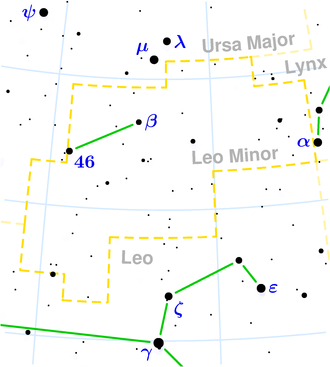IC 2604
| Galaxie IC 2604 | |
|---|---|
 | |
| IC 2604[1] | |
| AladinLite | |
| Sternbild | Kleiner Löwe |
| Position Äquinoktium: J2000.0, Epoche: J2000.0 | |
| Rektaszension | 10h 49m 25,070s[2] |
| Deklination | +32° 46′ 21,80″[2] |
| Erscheinungsbild | |
| Morphologischer Typ | SB(s)m[2][3] |
| Helligkeit (visuell) | 14,2 mag[3] |
| Helligkeit (B-Band) | 14,8 mag[3] |
| Winkelausdehnung | 1,2′ × 0,9′[3] |
| Positionswinkel | 40°[3] |
| Flächenhelligkeit | 14,1 mag/arcmin²[3] |
| Physikalische Daten | |
| Zugehörigkeit | NGC 3396-Gruppe LGG 218[2][4] |
| Rotverschiebung | 0.005447 ± 0.00001[2] |
| Radialgeschwindigkeit | 1633 ± 3 km/s[2] |
| Hubbledistanz vrad / H0 | (72 ± 5) · 106 Lj (22,1 ± 1,5) Mpc [2] |
| Durchmesser | 25.000 Lj |
| Geschichte | |
| Entdeckung | Stéphane Javelle |
| Entdeckungsdatum | 7. Mai 1887 |
| Katalogbezeichnungen | |
| IC 2604 • PGC 32390 • CGCG 184-017 • MCG +06-24-016 • 2MASX J10492498+3246217 • GALEXASC J104924.94+324621.9 • WISEA J104925.11+324621.6 • NSA 090213 | |
IC 2604 ist eine Balken-Spiralgalaxie vom Hubble-Typ SBm im Sternbild Kleiner Löwe am Nordsternhimmel. Er ist rund 72 Millionen Lichtjahre von der Milchstraße entfernt und hat einen Durchmesser von etwa 25.000 Lichtjahren. Sie gilt als Mitglied der elf Galaxien zählenden NGC 3396-Gruppe (LGG 218).
Im selben Himmelsareal befinden sich u. a. die Galaxien NGC 3395, NGC 3396, IC 2608, IC 2613.
Das Objekt wurde am 7. Mai 1887 von Stéphane Javelle entdeckt.[5]
Weblinks
Einzelnachweise
Auf dieser Seite verwendete Medien
Autor/Urheber: Torsten Bronger, Lizenz: CC-BY-SA-3.0
This is a celestial map of the constellation Leo Minor, the Small Lion.
Autor/Urheber: The Pan-STARRS1 Surveys (PS1) and the PS1 public science archive have been made possible through contributions by the Institute for Astronomy, the University of Hawaii, the Pan-STARRS Project Office, the Max-Planck Society and its participating institutes, the Max Planck Institute for Astronomy, Heidelberg and the Max Planck Institute for Extraterrestrial Physics, Garching, The Johns Hopkins University, Durham University, the University of Edinburgh, the Queen's University Belfast, the Harvard-Smithsonian Center for Astrophysics, the Las Cumbres Observatory Global Telescope Network Incorporated, the National Central University of Taiwan, the Space Telescope Science Institute, the National Aeronautics and Space Administration under Grant No. NNX08AR22G issued through the Planetary Science Division of the NASA Science Mission Directorate, the National Science Foundation Grant No. AST-1238877, the University of Maryland, Eotvos Lorand University (ELTE), the Los Alamos National Laboratory, and the Gordon and Betty Moore Foundation., Lizenz: CC BY-SA 2.5
IC 2604 - PanSTARRS1
Autor/Urheber: Torsten Bronger, Lizenz: CC-BY-SA-3.0
This is a celestial map of the constellation Leo Minor, the Small Lion.



